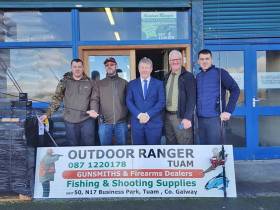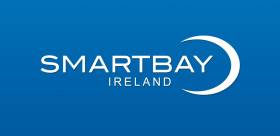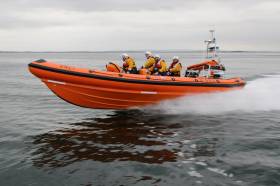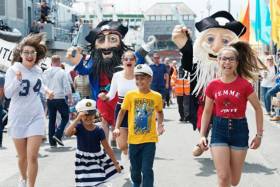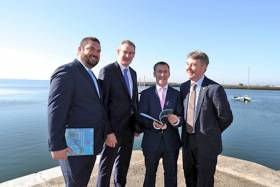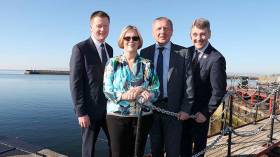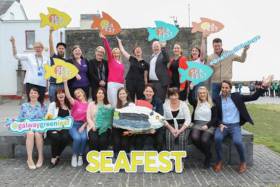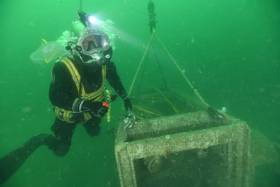Displaying items by tag: Galway
New Angling Outreach Initiative Reels In Novices In Galway
#Angling - The Outdoor Ranger Tuam Angling Education Programme provides information sessions, skills workshops and fishing excursions to young people who may be interested in trying out the pursuit.
Sean Canney TD, Minister of State with responsibility for inland fisheries, expressed his full support for the Tuam-based programme this week and welcomed the funding from Inland Fisheries Ireland’s National Strategy for Angling Development Fund to support its rollout.
“This programme will encourage and engage young people in angling and allow experienced volunteer anglers from local clubs to pass on their knowledge and skills to the next generation,” Minister Canney said.
“Collaboration such as this is vital to ensure that these skills, developed over many years, are not lost. I am particularly pleased that the Outdoor Ranger Tuam Angling Education Programme is supported locally by Cairde an Chláir working with Inland Fisheries Ireland.”
The programme commenced in October with a strong uptake, and participants enjoyed guest appearances from well-known anglers during the programme.
Nathan Creaven from Kilconly, Tuam who fly-fished for Ireland earlier this year, demonstrated his fly-tying skill, while Owen Trill, and international fly-tier from Galway, gave his own demonstration at one of the skills workshops.
The information sessions and workshops aimed to provide students with the basic skills necessary for recreational angling. Young people took several lessons on several topics including sustaining quality habitats, line rigging, baiting, knot-tying, casting techniques, fish retrieval, fish handling, catch and release, rules and regulations of angling and biosecurity.
In addition, they enjoyed a fishing trip to Oughterard Fishing School where they had the opportunity to put their new found angling skills to practise.
The programme received funding from IFI’s National Strategy for Angling Development Fund. The strategy aims to ensure that Ireland’s angling resource is protected and conserved in an environmentally sustainable manner for future generations to enjoy while also striving to make angling an accessible and attractive pursuit for all.
Suzanne Campion, Head of Business Development at Inland Fisheries Ireland said: “We are delighted to support the Outdoor Ranger Tuam Angling Education Project through our National Strategy for Angling Development.
“It is through partnerships such as this one [in Tuam], where local fishing clubs and associations are working together in a constructive and positive manner, that we will secure the future of our fisheries resource,” said Suzanne Campion, IFI’s head of business development.
Teresa Kelly from the Outdoor Ranger shop in Tuam added: “Learning to become an angler is something we took for granted when we were young. We took our bike out and headed off to the river for the day. But this is a thing of the past and the amount of young people that don’t know anything about angling, or that it’s even a sport, is shocking — especially as we have the finest rivers and lakes at our doorstep.
“This is the issue that the Outdoor Ranger Tuam Angling Education programme wants to highlight and also to make changes by providing information and day trips out fishing with young people to give them to the opportunity to learn and gain a love of angling.”
In other news, applications are open till 5pm this evening (Friday 30 November) for the Support Scheme for Former Eel Fisherpersons.
The fund offers a restitution payment specifically targeted at former licensed eel fisherpersons who were actively engaged with the commercial eel fishery prior to the National Eel Management Plans and the 2008 public consultation which subsequently lead to the closure of the commercial eel fishery.
Details on the scheme are available on the IFI website. Late applications will not be accepted.
SmartBay Project Recruiting Community Liaison Co-ordinator
#Jobs - SmartBay Ireland is seeking to recruit a community liaison co-ordinator for its marine and renewable energy test site and subsea observatory in Galway Bay.
The successful candidate will have a contract with SmartBay, but the focus of the job “will be to facilitate communication between residents, community groups, schools, local businesses and interested parties with the view to increasing local understanding and support” for the SmartBay project off Spiddal.
Written and verbal fluency in both English and Irish is a requirement for this role, as is a degree or equivalent experience in community development or a related subject.
The closing date for applications is Wednesday 31 October. The full job description and details on how to apply can be found here in English, and also as Gaeilge.
New Angling Bye-Laws For Corrib Catchment In Galway & Mayo
#Angling - Seán Kyne, Minister of State with responsibility for the inland fisheries sector, has signed off three new angling bye-laws which affect the Corrib catchment in Galway and Mayo.
The bye-laws, which have been requested by local angling clubs, concern the Abbert and Grange Rivers, the Clare River and the Cong River and Canal, and reflect the support of the clubs for the conservation imperative and the sustainable management of the local fisheries resource.
The Abbert and Grange Rivers (Annual Close Season) Bye-Law extends the closed season for all angling on the Abbert and Grange Rivers by two months to cover the period from the 1st of September until the 31st of March annually.
This bye-law is being introduced at the request of the angling clubs on the Clare system and will act as a vital conservation measure.
Both rivers make a significant contribution to wild brown trout stocks in the Clare River system and Lough Corrib. The new bye-law will afford greater protection to spawning salmonids in these two very important tributaries of the Clare River.
The Western Fisheries Region River Clare (Revocation) Bye-Law permits all legal angling methods on the Clare River from Daly’s Bridge in the townland of Corrandrum to a point 300 metres upstream of the footbridge at Anbally in the townlands of Anbally and Turloughmartin, Co Galway.
This section of river was previously restricted to fly fishing only. However, this new bye-law will bring this short section of the river into line with the rest of the Clare River. This bye-law was introduced at the request of the local angling club.
The Upper and Lower Limits of Cong River and Cong Canal Bye-Law clearly defines the upstream boundary between Lough Mask and the Cong Canal and the downstream boundary between the Cong River and Lough Corrib.
The purpose of the bye-law is to enable the effective enforcement of legislation governing the open angling seasons for trout and salmon on the Cong Canal/River as these differ from the open seasons for these species on Loughs Corrib and Mask.
This bye-law will also remove any difficulty in identifying the correct angling season at the extremities of the Cong River/Canal and will afford greater protection to highly prized ferox trout which are known to spawn in the Cong River/Canal.
“We welcome the introduction of these bye-laws in Galway and Mayo which will help us to enforce relevant legislation and enhance the resource in the long term,” said Inland Fisheries Ireland chief executive Dr Ciaran Byrne.
“The introductions of these bye-laws follow public consultations whereby stakeholders were invited to input their views and insights into the proposed new regulations. Inland Fisheries Ireland’s fisheries officers will now protect these rivers in line with the new laws in place.”
Anglers are requested to familiarise themselves with the details of the new bye-laws, which can be found on the website of the Department of Communications, Climate Action & Environment.
#RNLI - Three young German visitors were rescued by Galway RNLI after getting stranded on Hare Island in Galway Bay yesterday afternoon (Thursday 26 July).
The three students were trapped on the island after the tide came in shortly before 12.30pm.
A passer-by on the shore spotted the group and dialled 999 for assistance. Galway RNLI’s lifeboat was subsequently called to the scene and arrived within 10 minutes.
The students were completely surrounded by water when the lifeboat arrived to assist them on board. They were then taken to Galway Docks in the city, where they are staying. They did not require medical assistance.
The lifeboat crew on this callout were helm Sean King, Cathal Bryne, Greg Cullen and Olivia Byrne, who said: “This highlights the dangers of going out to Hare Island when the tide is coming in.
“These young men got completely cut off in a short space of time. Luckily a diligent observer on the shore came to their assistance and contacted the emergency services straight away.”
Strandings are not an uncommon occurrence at the tidal island, with similar incidents in 2010, 2013, 2016 and last September.
SeaFest Nominated For National Event Industry Award
#SeaFest - SeaFest has been nominated for two awards in the Event Industry Awards 2018.
The 2017 edition of Ireland’s national maritime festival has been shortlisted for ‘Best Live Event’ and ‘Best Cultural Event’ in this year’s awards, with the overall winners set to be revealed next Friday 20 July.
The Event Industry Awards is the premier awards ceremony for the event sector in Ireland, and showcases the highest standards in Ireland’s event industry.
Sinéad Coyne, communications manager for the Marine Institute and SeaFest, said: “We are really delighted and honoured to be shortlisted for two categories in this year’s Event industry Awards alongside so many well-established companies. Congratulations to everyone involved and we look forward to the awards ceremony on July 20th at Citywest Hotel, Dublin.”
SeaFest creates awareness of Ireland’s maritime heritage and celebrates the many ways our seas and oceans enrich our lives.
A relative newcomer to the festival scene in Ireland, SeaFest has quickly become one of the most popular events in the country. Now in its fourth year, the festival has grown in attendance and scope – attracting 10,000 visitors in 2015, 60,000 visitors in 2016 and more than 100,000 visitors this year.
All entertainment, events and activities at SeaFest are free, and 103,000 visitors flocked to Galway Harbour to enjoy a host of activities and entertainment on and around the water from Friday 29 June to Sunday 1 July. In addition, the festival generated over €6.5 million in direct income for Galway’s tourism industry.
Global event specialists Arcana were appointed event managers for SeaFest and worked with the Marine Institute and over 20 local, regional and national organisations and agencies to stage the three-day festival.
#OurOceanWealth - New research from NUI Galway’s Socio-Economic Marine Research Unit (SEMRU) focuses on the ecosystem service benefits that society receives from Ireland’s marine environment.
The latest bi-annual report — Valuing Ireland’s Marine Ecosystem Services — was launched at the recent fifth annual Our Ocean Wealth Summit in Galway by Damien English, Minister of State for Housing and Urban Development, and Seán Kyne, Minister of State for Natural Resources, Community Affairs, and Digital Development.
Marine ecosystem services are provided by the processes, functions and structure of the marine environment that directly or indirectly contribute to societal welfare, health and economic activities. These services are vital to ensuring blue growth in Ireland’s ocean economy, which was valued at €1.8 billion or approximately 1% of gross domestic product (GDP) in 2017.
Factoring marine ecosystem service values into ocean economy account frameworks may help to ensure a sustainable ‘blue economy’ for Ireland by making sure that growth in the ocean economy does not exceed the carrying capacity of the marine environment.
While the value of some of these goods, such as fishing and aquaculture, are somewhat easier to measure, the value of many other benefits — such as carbon sequestration, waste assimilation and marine-related recreation — are often not captured by a price in any established markets.
However, without incorporating these values into marine planning processes, these benefits may be ignored or underestimated leading perhaps to suboptimal decision making.
Marine Institute chief executive Dr Peter Heffernan welcomed the new report, commenting: “This assessment of Ireland’s marine ecosystem services and their value is an important step in incorporating ecosystem services into policy and decision making related to Ireland's marine and coastal zones.”
SEMRU director Dr Stephen Hynes added: “Blue growth is about fostering development in marine economic activities in such a manner that the long term ability of the marine environment to continue to provide ecosystem service benefits is not compromised.
“This is exactly what Harnessing Our Ocean Wealth: An Integrated Marine Plan for Ireland is aimed at achieving. Knowing what those benefits are and what they are worth is vital for deciding on the best use of our marine resources and to ensure blue growth for our ocean economy far into the future.”
Commenting on the significance of the report, Dr Micheál Ó Cinnéide, director of the office of communications and corporate services at the Environmental Protection Agency (EPA), said it “adds greatly to our understanding of the value of our marine province. Anybody who was able to see the marvellous RTÉ documentary on Ireland’s Deep Atlantic in 2018 and who follows the pioneering work of researchers in the Marine Institute, Galway and Cork can appreciate that we are unlocking the treasures of our offshore world.
“As this report shows, the true value has to include the natural capital, economic potential, cultural and spiritual values. The EPA and the Irish Forum on Natural Capital looks forward to a wider national debate on safeguarding this priceless marine ecosystem for future generations.”
Valuing Ireland’s Marine Ecosystem Services is based upon research supported by the EPA and is based on previous research conducted under the Marine Institute’s Beaufort Award.
The full report is available to download from NUI Galway, with the technical version on the EPA website.
Summary of economic contribution of marine ecosystem services:
- The provisioning marine ecosystem services of fisheries and aquaculture is estimated to be worth €473 million per annum to all fleets and producers operating in Irish waters.
- Seaweed harvesting is valued at €4 million and aquaculture at €150 million.
- The regulating and maintenance ecosystem services of carbon sequestration are valued at €815 million per annum, waste assimilation services €317 million and coastal defence services of €11.5 million.
- The cultural ecosystem services of scientific and educational services are valued at €11.5 million, and the added value per annum to housing stock of being at the coast (aesthetic services) is valued at €68 million. On an annual basis, recreational services provided by the marine ecosystems are estimated to have an economic value of €1.7 billion.
- Even though not all of the ecosystem services provided by the marine environment can be monetarised, the report indicates that the value of those that can is substantial.
#OurOceanWeath - Employment growth of more than 16% in the marine sector was among the encouraging statistics cited by Marine Minister Michael Creed in his address to the Our Ocean Wealth Summit, which opened at Galway Docks yesterday (Thursday 28 June).
“Ireland has taken important strides in recent years in developing our blue economy. This is being driven at the highest levels of Government and represents a unique and joined up approach to growing Ireland’s blue economy.
“The work of our cross Departmental high level Marine Co-ordination Group (MCG), which I chair, will continue as we seek to build on recent success,” Minister Creed said.
Updated statistics indicate that the direct economic value of Ireland’s ocean economy now stands at €2 billion, or approximately 1% of GDP, which represents a 21% increase on 2015 figures.
“The 2017 estimates suggest that our ‘blue economy’ continues to grow at a faster pace than the general economy,” the minister added. “Growth in 2017 is being driven by strong performances in the aquaculture, sea fisheries, shipping and marine tourism industries as well as continued growth in the emerging ocean industries.
“A really encouraging statistic is the growth in employment for the marine sector which has risen from 27,888 (FTEs) in 2015 to an estimated 32,509 (FTEs) in 2017, an increase of 16.6%.”
Minister Creed also announced the publication of the latest annual Progress Report on Ireland’s Integrated Marine Plan - Harnessing Our Ocean Wealth.
“This report which covers inputs from across state departments and agencies, provides a wealth of information, spanning governance, research, education, international co-operation, business development, sustainability, and protection and conservation of marine ecosystems,” he said.
The Our Ocean Wealth Summit, now in its fifth year, forms a key part of the Government's integrated plan for Ireland’s marine sector and brings together national and international expert speakers, industry leaders, business development agencies and the Irish business and marine research community. This year’s discussions focused on the overall theme of ‘Investing in Marine Ireland’.
Ahead of the summit, PwC and the Marine Institute released the results of a joint survey of leading voices in Ireland’s maritime industry, which revealed “overwhelming confidence in Ireland’s maritime sector in spite of challenges posed by Brexit”.
Other findings include the potential of offshore wind and ocean energy, which is seen as a key opportunity for the marine sector, while overall, maritime leaders believe further investment in the marine industry is critical.
The Our Ocean Wealth Summit is part of a range of industry and innovation events taking place in Galway as part of SeaFest 2018, Ireland's national maritime festival, which opens today (Friday 29 June). A wide range of public events are taking place in Galway Harbour and Docks and the city over the weekend till Sunday 1 July.
Among them will be Life and the Sea, a special civic and military commemorative event to remember all those who have lost their lives at sea, and recognising the heroism of the men and women of our rescue services.
Mayor of Galway City, Niall McNelis, will address the special commemoration which will take place at 6pm on board the LÉ William Butler Yeats in Galway Harbour.
There will be musical performances, while poems will be read by Tony Hiney, community fundraising manager of the Western Region of the RNLI, and Lt Cdr David Fleming, Officer Commanding of the LÉ William Butler Yeats.
Minister of State Seán Kyne, accompanied by Mayor McNelis, and RNLI, Irish Coast Guard, Naval Service and Air Corps representatives will lay a wreath.
A lone piper will play, which will be followed by ship horns and a flyover by the Air Corps.
#SeaFest - Businesses across Galway are saying ‘No to Plastic’ in our oceans to support SeaFest, Ireland's national maritime festival, taking place in Galway Harbour from Friday 29 June to Sunday 1 July.
This year, the festival aims to highlight the impact of plastics in our oceans, with a particular focus on reducing single-use plastics on the festival site.
The initiative is organised by the Marine Institute, in conjunction with Galway City Council’s European Green Leaf programme.
“A truck load of plastic waste finds its way into the ocean every minute of every day, and it's estimated that by 2050 there could be more plastic by weight than fish in the ocean unless behaviours change,” said Marine Institute chief executive Dr Peter Heffernan.
“I applaud the businesses of Galway that are supporting SeaFest, and have committed to reducing single-use plastics by offering alternatives for customers. These small changes can result in big impacts, which will encourage a change in behaviours long after the festival weekend.”
Arlene Finn, European Green Leaf co-ordinator with Galway City Council, added: “We can all find a way to use less ‘single use’ plastic, and I congratulate the SeaFest supporters for taking the initiative.
“CPL Recruitment have provided all staff with re-useable water bottles and water filters to minimise bottled water waste. Celestica are banning disposable cups from the site and giving free travel mugs to employees. Food For Thought and 56 Central have moved away from plastic straws, providing biodegradable options instead. Brazo Coffee Academy have signed up for ReCupán and Refill.ie to support customers who use reusable coffee cups and water bottles.
“We welcome more businesses to come on board with this initiative, and hope they will take inspiration from those already involved.”
Other supporters of this initiative include Galway City Museum, Galway Atlantaquaira, Food For Thought, Honest Kitchen, Irish Greyhound Board, Junior Chamber of Commerce, Temple Café, The Yield Lab Europe, The Heron’s Rest, Tropical Medical Bureau, Glenville Nutrition, Galway Convention Bureau, Bank of Ireland Galway and AMACH! LGBT Galway/Teach Solais Resource Centre.
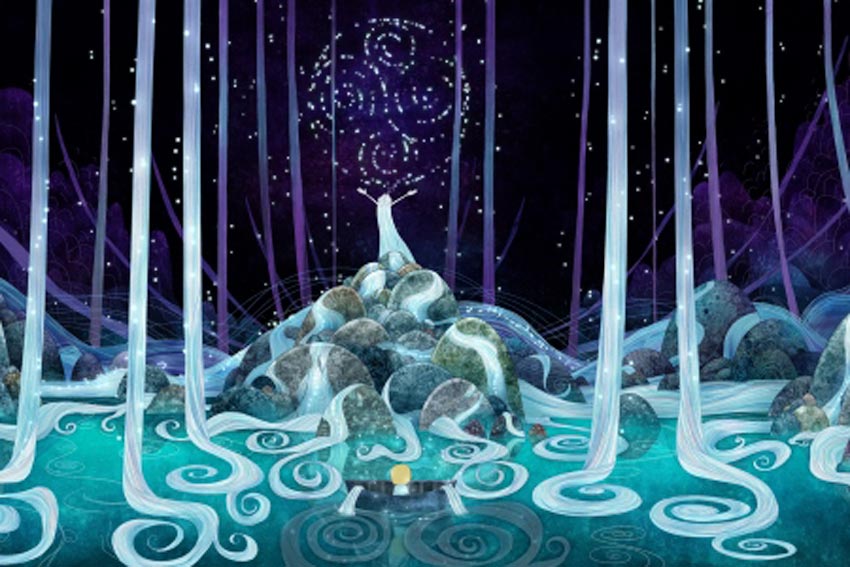 A still from Cartoon Saloon’s Song of the Sea
A still from Cartoon Saloon’s Song of the Sea
Meanwhile, a mesmerising cinematic experience will showcase some of the best ocean-inspired films and talks at SeaFest 2018.
The Atlantic Theatre will host free talks from renowned cameraman Doug Allan, as well as screenings of the documentary Ireland’s Deep Atlantic and children’s animation Song of the Sea.
A purpose-built marquee to accommodate 500 people will be erected at Galway Docks to create the Atlantic Theatre.
“We are delighted to be able to host seven talks from the renowned Doug Allan, all completely free to SeaFest visitors,” said Caroline Bocquel, Marine Institute director of corporate services. “His shows have been known to sell-out quickly, and we believe this will be one of the popular attractions at this year's festival.”
Underwater cameraman Ken O’Sullivan will take visitors on a deep sea journey in search of whales, sharks and cold water coral reefs in the documentary Ireland’s Deep Atlantic, which captured the attention of the entire country last month when the two-part series aired on RTÉ television.
The audio visual attractions continue with the 3D Under the Sea Dome. This engaging interactive experience will take viewers below the ocean surface to view creatures of all sizes – from tiny microscopic organisms to the enormous Humpback Whale. And the film Dynamic Earth, narrated by Liam Neeson, explores the interlocking systems that shape our climate.
In addition to the Atlantic Theatre, SeaFest 2018 will also offer a host of activities on the water such as performances from world champion flyboarders and vessel tours as well as sailing and kayaking sessions. Live seafood cookery demonstrations, a Defence Forces display and kids’ activities are all part of the packed programme of free events.
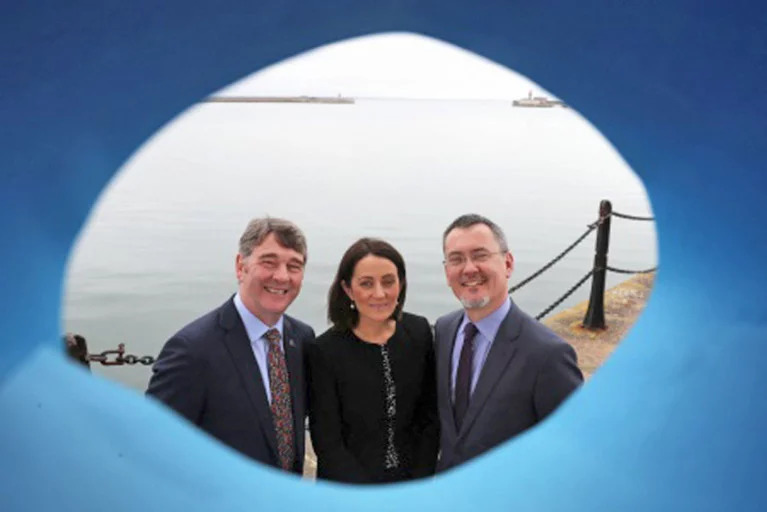 Marine Institute CEO Peter Heffernan, PwC partner Yvonne Thompson and BIM chief Jim O’Toole the launch of the 2018 Our Ocean Wealth Summit
Marine Institute CEO Peter Heffernan, PwC partner Yvonne Thompson and BIM chief Jim O’Toole the launch of the 2018 Our Ocean Wealth Summit
Ahead of SeaFest, enormous opportunities for Irish businesses operating in sectors such as engineering, energy, food and technology to expand their offerings to the marine sector will be discussed at the Our Ocean Wealth Summit in association with PwC at Galway Docks on Thursday 28 and Friday 29 June.
For entrepreneurs, start-ups and businesses interested in finding out more, the summit – under the theme ‘Investing in Marine Ireland’ – includes conference and panel sessions with thought leaders and innovators, as well as a marine trade showcase with exhibits across drone technology, smart shipping, offshore and onshore communications, marine waste management and financial modelling for the marine sector and more.
There will also be ample networking opportunities to connect with national and international businesses, government representatives and speakers from the USA, Europe, UK and Ireland.
#Rowing: The Workmen’s junior women’s double took a silver at the National Schools’ Regatta at Dorney Lake in England today. In the Championship Doubles, Annie O’Donoghue and Ciara Browne finished one and a half lengths down on Latymer Upper School. Ciara Moynihan of Workmen’s finished seventh in the A Final of the Championship Singles, while Molly Curry of Coleraine Grammar School took control of the B Final and won.
Enniskillen took silver in the Boys’ Non-Championship Eights, and their girls’ junior 16 coxed four matched them in their A Final. Ireland clubs placed second and third in the B Final of the Girls’ Championship/Non Championship Eights.
British National Schools’ Regatta, Dorney Lake (Selected Results; Irish interest)
Saturday
Boys
Championship/Non-Championship Eight – B Final: 3 Enniskillen RBC.
Girls
Championship/Non-Championship Eight – B Final: 2 Galway 7:35.72; 3 St Michael’s 7:45.46.
Junior 16 Four, coxed – A Final: 2 Enniskillen RBC 8:22.68.
Sculling, Double – Championship A Final: 2 Workmen’s (A O’Donoghue, C Browne) 8:06.37.
Single – Championship A Final: 7 Workmen’s (C Moynihan) 9:10.40. B Final: 1 Coleraine Grammar School (M Curry) 8:43.03.
#MarineScience - The SmartBay Observatory in Galway Bay will be brought ashore for essential maintenance in the coming days.
Last week Ocean Crest Marine, with diver Mark Kerrigan, prepared for the recovery of the underwater observatory, located 1.5 km off the coast of Spiddal, which has been continuously monitoring the underwater environment over the past 15 months.
It uses cameras, instruments and sensors for continuous live underwater observations giving marine scientists and other ocean researchers unique real-time access to monitor ongoing changes in the marine environment.
Over the coming weeks, the observatory will be thoroughly cleaned, all the scientific instruments will be replaced, and new underwater lamps will be added to improve the high-definition video camera footage.
“We also plan to install a microplastics sampling net and a new underwater stills camera in partnership with European marine science researchers,” said Alan Berry of the Marine Institute.
These research projects are due to commence mid-July, when the observatory will be reinstated, to continue to collect important information on the marine environment from the depths of Galway Bay.
The SmartBay Observatory in Galway Bay contributes to a growing global network of real-time data capture systems deployed within the ocean.
Data relating to the marine environment at the site is transferred through a fibre-optic cable to the Marine Institute headquarters and onwards onto the internet.
This data includes a live video stream, the depth of the observatory node, the sea temperature and salinity, and estimates of the chlorophyll and turbidity levels in the water which give an indication of the volume of phytoplankton and other particles, such as sediment, in the water.


























